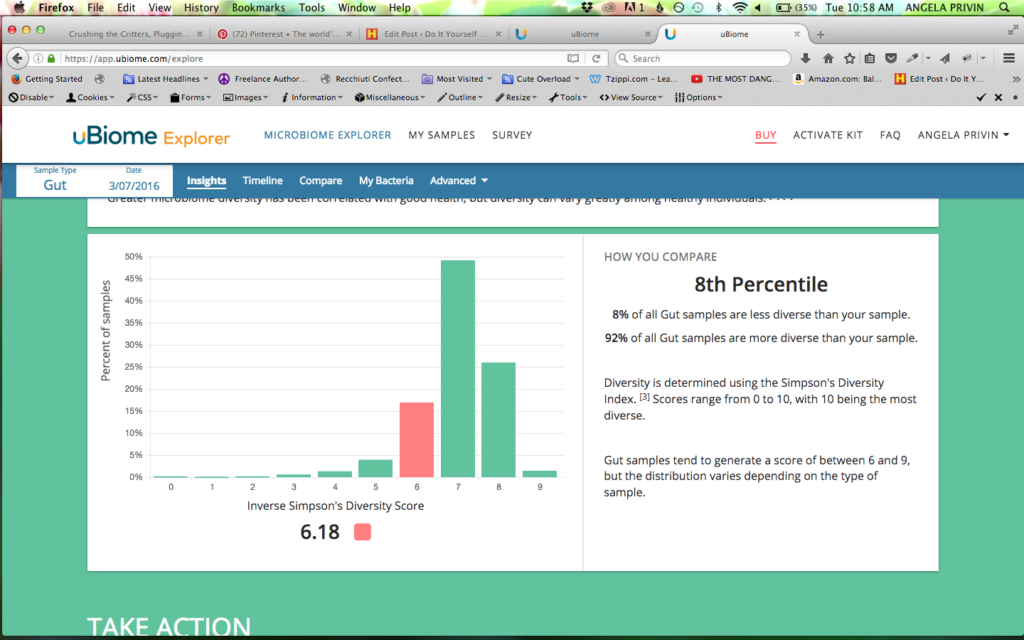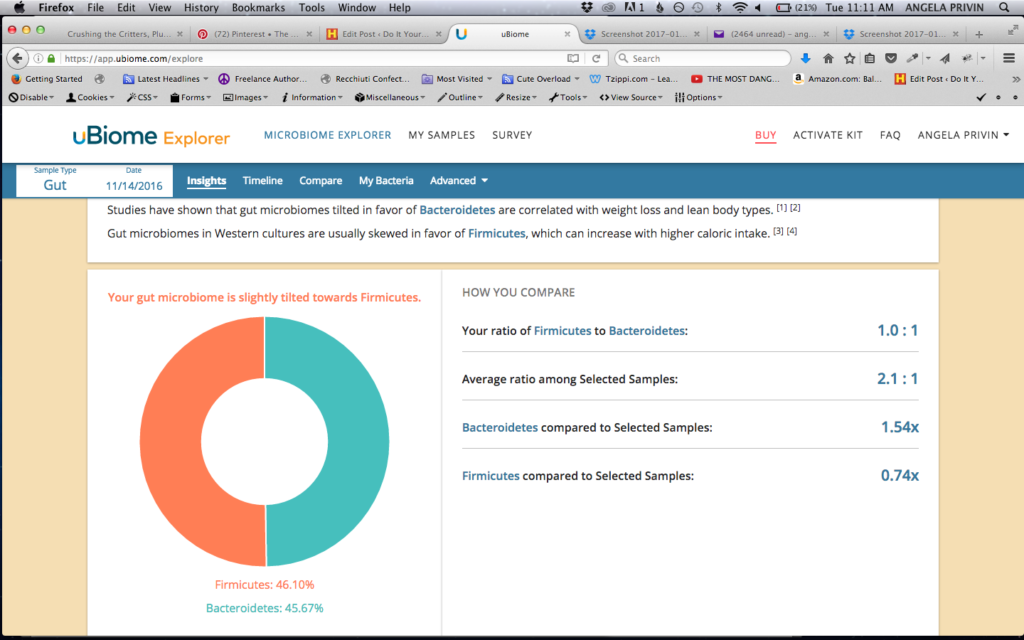When it comes to IBS, testing is extremely valuable because it helps people narrow down the root cause of their digestive imbalance. Without testing, it’s easy to spend years in the often fruitless process of trial and error.
In my experience however, people don’t like to invest in testing. They’ve already been through a bunch of tests with their doctor and none of it showed anything wrong. They lose faith in testing.
The tests your doctor gave you are not the right tests. They don’t get at the root cause of IBS. They just rule out everything else out. The testing that I do with clients checks for targeted infections in the large and small intestines, as well as hormonal disregulation. You can read more about those tests here. Most doctors don’t run these tests and yet, in my opinion, these are the tests that really matter.
But today I want to write about another type of test, that you don’t need any health practitioners to order or interpret for you. This home test will empower you with information you need to track your recovery progress and figure out if your supplements and probiotics are actually working for you.
This is a test that I use regularly at home to track what’s going on inside my body and how certain lifestyle or diet changes or cleanses affect my bacterial balance. The test is called Ubiome and it takes a few minutes to do. It’s also non invasive and inexpensive. And it doesn’t require you to prepare or change anything in your life to take it, like the other gut tests do.
This home test will map out the bacteria in your gut, and what’s even more interesting is if you order multiple kits, it will show you how that bacteria changes over time based on the diet, supplements, probiotics, medications and stress you are experiencing.
It would be particularly interesting to take this test before and after taking antibiotics to see the effect it has on your gut flora and then how your gut recovers from the antibiotic assault.
This test does not diagnose any diseases or isolate pathogenic bacteria, it simply gives you a snapshot of every bacteria that’s living in your gut, including the rare ones.
In this blog post I’m going to demystify this test, explain how to read it and how I use it personally.
Cost
Depending on the option you chose, this this test costs between $66 and $89 a kit. And if you use my discount code link at the end of this article you can get an additiona 15% off. It can cost you less than some high-end probiotic supplements. And it can tell you if those supplements are really working for you.
I recommend ordering the time lapse kit, which is 3 kits for $199, and the kits last up to two years if you refrigerate them. If you use them within a year they don’t need refrigeration.
There’s also the 5 site kit that tests bacteria in the nose, skin, mouth and genitalia. This is the most expensive option and only interesting for those you have issues with their skin, sinuses, teeth/mouth or suffer from yeast infections. Otherwise just focus on the gut kit.
The benefits of testing
I’m always asked what the best probiotic supplement is? I’ll be blogging about my favorite brand next week but the answer really is…it depends on what you need.
The ubiome test will tell you if you are low in bifido or lactobaccilus and if your probiotic is providing those.
Most people spend around $60 for high quality probiotics and have no assurance that they are working. You can rotate different brands on a monthly basis and test your bacterial balance every month with a monthly subscription kit.
Some people judge their probiotics by how they feel, but this could be attributed to the placebo effect (believing the probiotics will help), or some other factors. I prefer to see data because it’s a more reliable judge of what is and isn’t working, than emotional opinions.
You can also test the effects of adding new fermented foods.
How to take the test
This is the best part. It takes 2 minutes to take the test. The kit comes with a swab and a tube with liquid.
After pooping, you brush your swab against your used toilet paper. You need very little to sample, just enough to turn the water slightly brown. You swish the swab in the tube for 1 minute. Remove, close the cap and mail the sample in the enclosed, prepaid, pre-addressed envelop. You then register your kit number on the Ubiome website. You’re done.
The results will be posted in your online portal in a few weeks. You’ll be notified by email when they are ready to view. The hardest part is waiting for the results (I know you feel me, fellow impatient ones).
How I use Ubiome
I’ve been using Ubiome for years. Last spring I used it to test the results of a 10 week online gut cleanse I signed up for. I took a sample before the cleanse and then one a week after ending it.
The gut program focuses on increasing bacterial diversity. But after testing I knew that gut program wasn’t a success. My diversity went from the high 80s to an 8. Yep, that’s right. An 8.

I blame that on all the oregano oil I took during the cleanse. Oregano oil is a powerful natural antibiotic. People who have a large balance of pathogenic bacteria may do well on oregano oil, but it wiped out the beneficial flora in my gut and left it a ghost town.
When I got the results I knew I had work to do, even though I felt fine. If I didn’t replenish my gut bacteria I knew I’d run into problems down the line when my body and mind were under stress or when I indulged too much.
I focused on probiotic supplementation and the right kind of prebiotic and fermented foods.
A subsequent retest showed I’d successfully built my diversity back to the mid 80s.
How to read your Ubiome test
The first part of the test shows your wellness match score, which compares you to everyone who’s taken this test. It shows you how your bacterial balance stacks up to the people who’ve reported few physical complaints.
It’s interesting but it’s the least important piece of information provided by the test. The important sections are body weight, probiotics, diversity and unique bacteria. I’ll go over each section.
Body weight will tell you how many bacteroidetes you have versus firmicutes in a pie chart format.

Mine are almost even with a bit more firmicutes.
The bacteriodetes are the bacteria that are associated with weight loss and lean body types. If you want to lose weight then your aim is to boost your bacteriodetes. This bacteria is extremly responsive to diet. By managing your carb intake you can boost the fat burning bacteria.
The firmicutes increase with a higher caloric intake. The biome in Western cultures is skewed towards firmicutes.You really don’t want firmicutes to dominate your biome as that is associated with obesity and it’s accompanying issues of diabetes/metabolic disorder, high cholesterol or high blood pressure.
Also, increases of bacteroidetes are seen in those with increased migrating motor complex (MMC) function. That means that your metabolism is higher. Food, fluids and waste move through you at a fast clip. This is very important for maintaining healthy gut function and preventing conditions like small intestinal bacterial overgrowth (SIBO), which can result from slow or malfunctioning MMC. This is also an indicator of constipation.
Working to increase bacteroidetes and decrease firmicutes can help with metabolism, weight loss or maintenance and regularity.
This section also measure akkermansia, which is a bacteria that is associated with inflammation. Having akkermansia that is too high or two low (against the marker of 2 %) is a sign that there’s inflammation present.
Again, this is not a diagnostic tool but simply a way to track how your diet, lifestyle and supplements effect on bacteria and inflammation.
The test will also give you some diet and lifestyle tips on how to improve your personal akkermansia, probiotics and bacteriodetes/firmicute balance.
The probiotics section measures your lactobacillus and bifidobacterium levels. This is where you can see if your probiotics has been doing what they promise to do.
Bifido is crucial for improving gastrointestinal symptoms and function. Lacto is associated with improved mental health, including anxiety and mood, in addition to improving gut health.
The next section is diversity and is pretty straightforward. You want your gut to be as diverse as possible. You can do this by eating a diverse diet.
Many people with food allergies narrow their diet down to 4 or so foods they can tolerate. This of course is understandable as the fear of eating food and being uncomfortable is enormous, but this will lower bacterial diversity and lead to a less healthy gut in the long term. And you can now have the data to prove it.
Eating only a few foods may keep you alive but won’t move you forward towards health. A low diversity score might motivate some people to diversify their diet with the help of a coach or practitioner familiar with food allergies and leaky gut.
Other things that decrease bacterial diversity is proton pump inhibitors (PPIs) prescribed to help with GERD, acid reflux and ulcers. As well as antibiotics.
Things that increase diversity are exercise and eating fiber-rich foods. However, be cautious, some people with gut infections like SIBO can flare up from eating the wrong types of fiber. That is why it’s important to test for SIBO.
Lastly, the test lists the bacteria in your gut that’s unique to you and rare in the general population. And there is also a taxonomy of all the bacteria found in your gut with the amounts of each bug. You can print this out and bring this to your health care professional for interpretation.
And just because a bug is rare does not mean that it’s harmful. One of my 10 most rare bacteria from my test is eubacterium. According to Ubiome, this bacteria is thought to help us digest resistant starches. I eat a lot of resistant starch from green plantains, yuca (cassava) and cold white potatoes.
Eubacteria flourish in the digestive tracts of women in their first trimester of pregnancy but are depleted in the guts of children with Autism Spectrum Disorders. This tells me it’s a good one to have.
I’m excited to share with you one of my favorite personal tools for managing my gut health. I value the importance of taking snapshots of how my body is doing over time and how it reacts to shifts in lifestyle, weight and diet.
Bacterial balance is so important when it comes to managing your health. It greatly influences how much you weigh, how you feel emotionally, how your immune system functions and how food is digested.
And as promised here’s the 15 percent off coupon if you purchase through this link and use the code provided.
When you click the link and are directed to the Ubiome site, go to the very top to the orange band and click on the box that says “get sequenced”. You will be able to choose between the single Ubiome kit, monthly subscription, time lapse 3 pack or the 5 site kit. And if you have any questions please email me or put then in the comment below. When you check out on the payment page you must put the code provided in the coupon code window. Shipping is free.
If you need help making sense of your data, I offer $50 discovery sessions where we can go over your results and strategize how to make changes and improvements.
Happy exploring!


